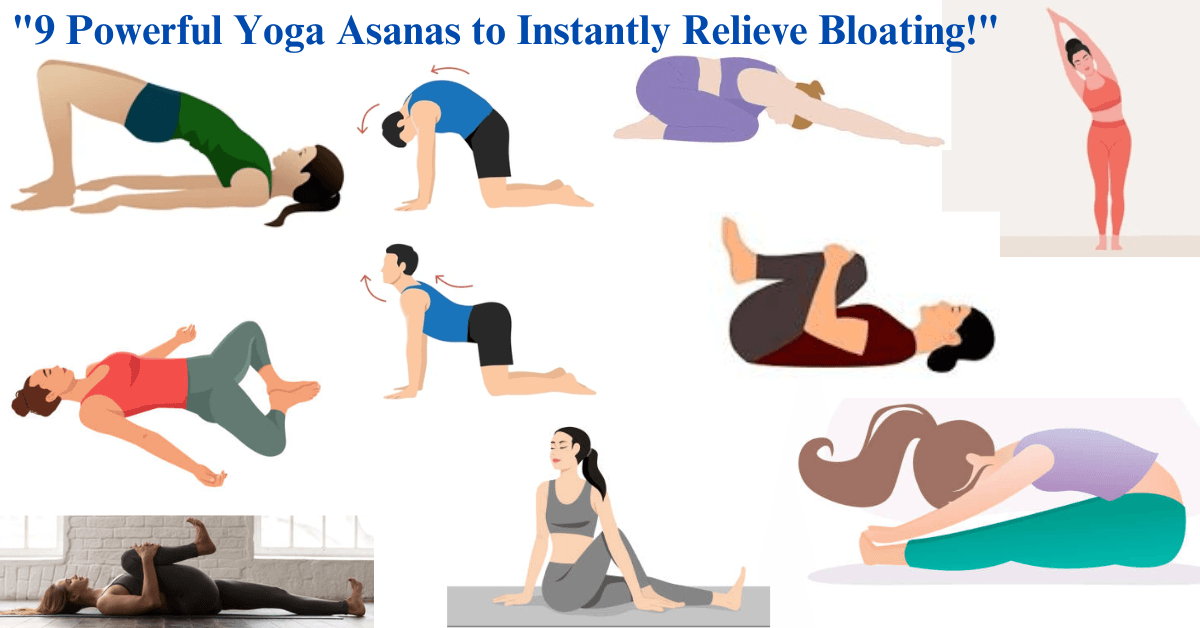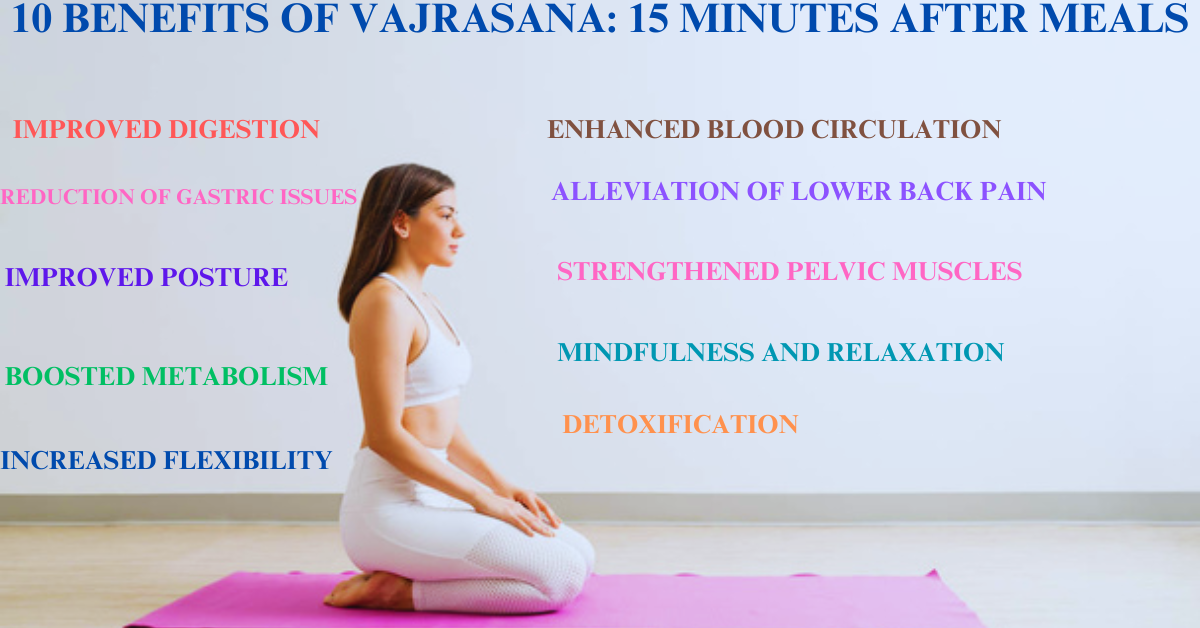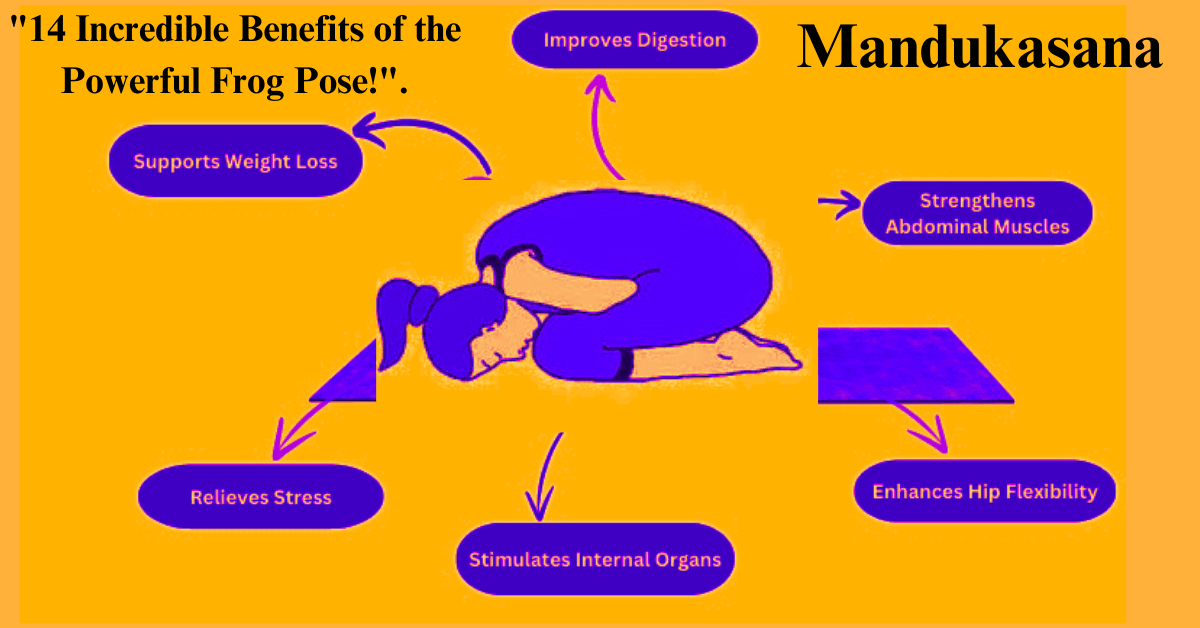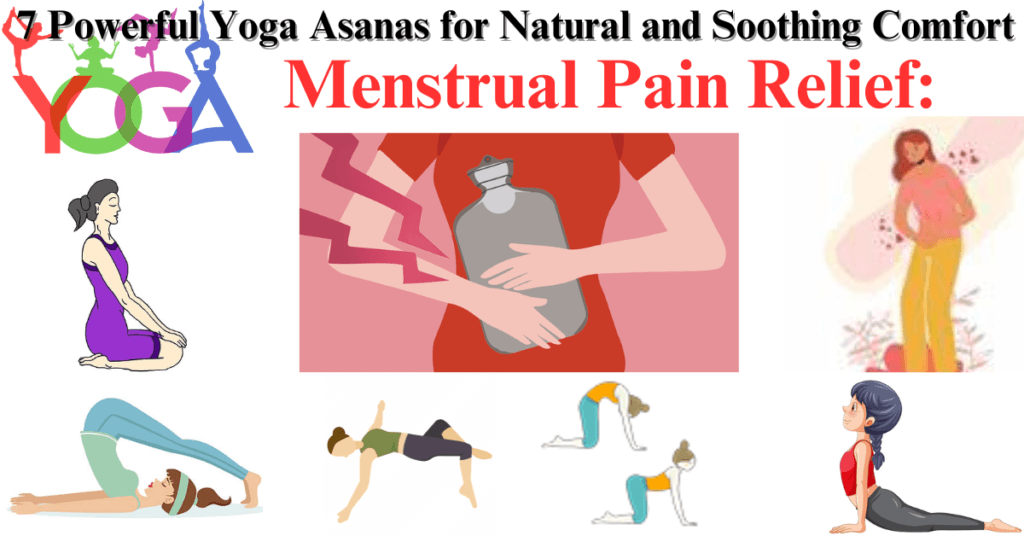
Table of Contents
Menstrual Pain Relief: 5 Powerful Yoga Asanas for Natural and Soothing Comfort
Menstrual Pain Relief : Menstrual pain, also known as dysmenorrhea, is a widespread concern among women. Characterized by cramping, lower back pain, and discomfort in the pelvic region, these symptoms can often disrupt daily activities. While medications provide temporary relief, yoga offers a natural, sustainable, and holistic solution to manage these pains effectively. Practicing certain yoga asanas during menstruation can alleviate cramps, enhance blood circulation, and promote relaxation. Let’s delve into 7 powerful yoga poses and how they can transform your menstrual experience.
7 Powerful Yoga Asanas for Natural and Soothing Comfort :
1. Child’s Pose (Balasana)
Child’s Pose is a gentle, restorative posture that targets the lower back, hips, and thighs. By easing tension in these areas, it directly relieves menstrual cramps while promoting a sense of calm. It’s an excellent pose for grounding and relaxation, making it ideal for relieving stress and anxiety during menstruation.
- Step-by-Step Guide:
- Kneel on the floor, keeping your big toes together and knees slightly apart.
- Sit back on your heels and stretch your arms forward, lowering your chest towards the floor.
- Rest your forehead on the mat and relax your shoulders.
- Breathe deeply and hold the pose for 1–3 minutes, focusing on releasing tension with each exhale.
- Benefits:
- Relaxes the lower back and hips.
- Enhances blood flow to the pelvic area.
- Calms the mind, reducing menstrual stress.
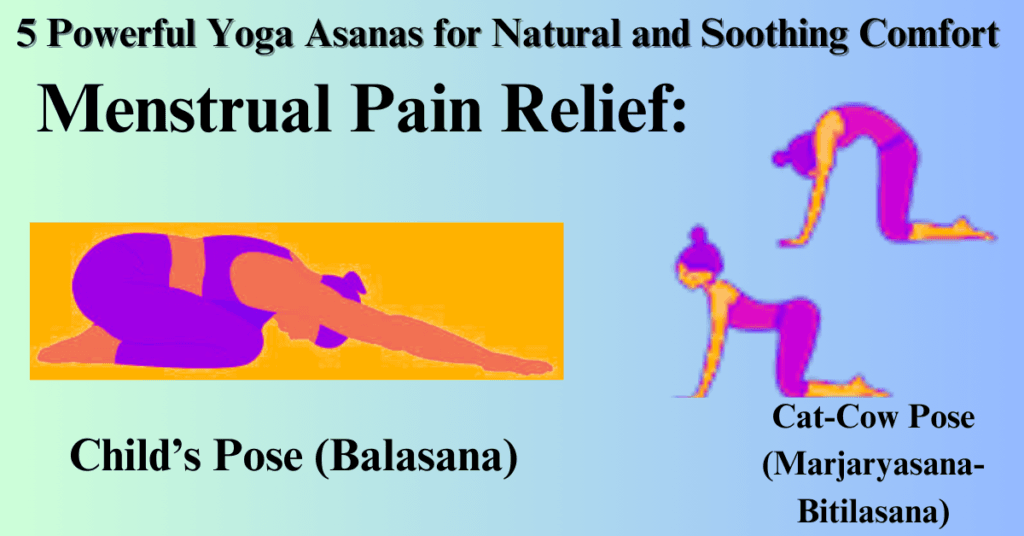
2. Cat-Cow Pose (Marjaryasana-Bitilasana)
Cat-Cow is a dynamic sequence that combines two poses to create a soothing, rhythmic flow. This movement massages the abdominal muscles, eases cramps, and improves flexibility in the spine. It also increases circulation in the pelvic region, providing natural relief from pain.
- Step-by-Step Guide:
- Start on all fours with your wrists aligned under your shoulders and knees under your hips.
- Cow Pose (Bitilasana): Inhale as you arch your back, lifting your head and tailbone upwards while allowing your belly to drop.
- Cat Pose (Marjaryasana): Exhale as you round your back, tucking your chin and drawing your belly button towards your spine.
- Repeat the sequence for 1–2 minutes, synchronizing your movements with your breath.
- Benefits:
- Massages abdominal and pelvic muscles.
- Reduces stiffness in the lower back.
- Promotes relaxation through mindful breathing.
3. Cobra Pose (Bhujangasana)
Bhujangasana, or the Cobra Pose, is a popular yoga asana known for its numerous benefits, especially for relieving back pain, strengthening the spine, and improving flexibility. The name comes from the Sanskrit words “bhujanga”, meaning “cobra,” and “asana”, meaning “pose,” due to the way the body mimics the raised hood of a cobra. This gentle backbend also provides relief from menstrual pain by improving circulation in the abdominal area and stimulating the digestive system.
How to Perform Bhujangasana (Cobra Pose)
- Starting Position:
- Begin by lying flat on your stomach with your legs extended and the tops of your feet resting on the floor.
- Keep your feet hip-width apart and your hands placed under your shoulders, with your elbows tucked close to your body.
- Position your forehead gently on the floor, and relax your body.
- Engage the Core:
- As you inhale, gently press your palms into the floor, activating your arms and lifting your chest off the ground.
- Use your back muscles to initiate the movement, rather than pushing up solely with your hands.
- Lift the Chest:
- Gradually raise your chest, upper abdomen, and ribs while keeping your elbows slightly bent and close to your body.
- Your forearms should remain parallel to the floor, and your shoulders should stay relaxed, away from your ears.
- Form the Cobra:
- Extend the chest and lift the head to look forward or slightly upward. Make sure to avoid overstraining the neck.
- Keep your elbows bent, with your arms providing support but not bearing the full weight of your upper body.
- Hold the Pose:
- Hold the pose for 15–30 seconds while taking deep, steady breaths. Focus on elongating your spine and opening your chest.
- Release:
- To release the pose, gently lower your chest and forehead back to the floor. Rest for a few moments in Savasana (Corpse Pose) before attempting it again.
Benefits of Bhujangasana (Cobra Pose)
1. Relieves Menstrual Pain
- Bhujangasana helps relieve menstrual cramps by improving blood circulation to the pelvic region. The gentle stretch of the abdominal muscles reduces tension and discomfort.
- By stimulating the reproductive organs, this pose aids in reducing menstrual pain and promotes overall abdominal health.
2. Strengthens the Spine
- As a backbend, Cobra Pose strengthens the spine, improving posture and alleviating back stiffness.
- It also tones the muscles in the back and buttocks, helping reduce the risk of back injuries and promoting mobility.
3. Improves Flexibility
- The Cobra Pose stretches the chest, shoulders, and abdomen, improving flexibility in these areas.
- It also stretches the spine, increasing its flexibility and promoting better posture.
4. Opens the Chest and Lungs
- Bhujangasana opens the chest and stretches the ribcage, helping expand the lungs and improve respiration.
- This can benefit those who have difficulty breathing deeply and helps with stress relief.
5. Stimulates the Digestive System
- The forward bending action of the pose massages the internal organs, particularly the digestive system.
- It stimulates the abdominal area, improving digestion, reducing bloating, and aiding in detoxification.
6. Reduces Stress and Fatigue
- This pose promotes a sense of calm and relaxation by opening the chest and lungs, facilitating deeper breathing.
- Bhujangasana is often used to combat stress and fatigue, as it can refresh the body and mind.
Precautions
- Avoid Cobra Pose if you have:
- Severe back injuries, herniated discs, or spinal issues.
- Carpal tunnel syndrome or wrist injuries, as pressure on the wrists may aggravate the condition.
- A neck injury, as improper alignment can strain the cervical spine.
- Pregnancy (avoid deep backbends, especially in the later stages).
- Modifications:
- If you experience discomfort in your lower back, try practicing Cobra Pose with your elbows slightly bent and engage your core more to support your spine.
- For beginners, it may be helpful to start with a smaller lift of the chest, gradually increasing as you build strength and flexibility.
Bhujangasana for Menstrual Pain Relief
To use Bhujangasana for menstrual pain relief, follow these guidelines:
- Perform the pose on lighter days of your menstrual cycle when the pain is less intense.
- Combine it with deep breathing to promote relaxation and pain relief.
- Hold the pose for shorter durations at first (15-20 seconds) and gradually increase the time as you become more comfortable.
Tips for Better Practice
- Warm Up:
- Begin with gentle stretches like Adho Mukha Svanasana (Downward Dog) or Bidalasana (Cat-Cow Pose) to prepare the spine for the backbend.
- Engage the Core:
- Focus on lifting with the back muscles, not just using your arms. Engaging your core is essential to avoid straining your lower back.
- Keep the Neck Neutral:
- Avoid overextending your neck. Keep your gaze forward or slightly upward while maintaining a neutral spine.
- Breathe Deeply:
- Practice mindful, deep breathing during the pose to help reduce tension and promote relaxation.
- Practice Consistently:
- Regular practice of Bhujangasana improves flexibility, strength, and the ability to hold the pose for longer periods, enhancing its benefits over time.
Bhujangasana (Cobra Pose) is a powerful asana that can bring great relief from menstrual discomfort while improving overall flexibility, spinal health, and digestive function. By incorporating Cobra Pose into your yoga practice, you can reduce menstrual pain naturally, strengthen your back, and cultivate a sense of calm and relaxation. With regular practice, the benefits of Bhujangasana will extend far beyond the menstrual cycle, contributing to your long-term well-being.
4. Supine Twist (Supta Matsyendrasana)
The Supine Twist is a gentle, restorative posture that stretches the spine and abdominal muscles. This twist helps release tension in the lower back and hips while improving digestion, which can often be disrupted during menstruation.
- Step-by-Step Guide:
- Lie on your back and bring your knees to your chest.
- Drop your knees to one side while keeping your shoulders flat on the ground.
- Extend your arms out to the sides, forming a “T” shape, and turn your head in the opposite direction of your knees.
- Hold for 1–2 minutes on each side, breathing deeply.
- Benefits:
- Eases tension in the lower back and pelvic region.
- Enhances spinal flexibility.
- Supports healthy digestion and reduces bloating.
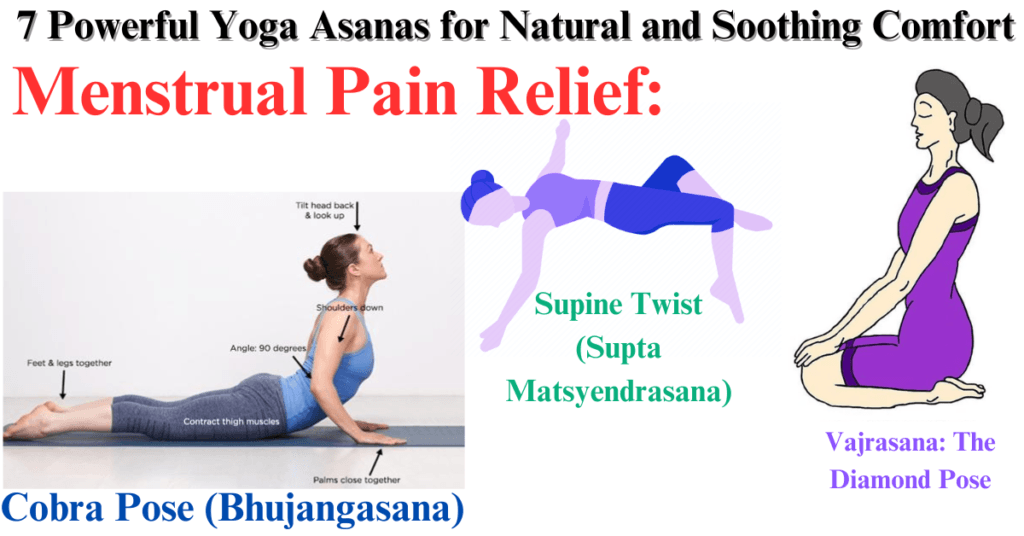
5. Vajrasana: The Diamond Pose
Vajrasana, also known as the “Diamond Pose” or “Thunderbolt Pose,” is one of the simplest yet most powerful yoga asanas. It is a seated posture that offers a range of benefits, from improving digestion to calming the mind. Vajrasana is unique in that it is one of the few poses you can practice immediately after eating, making it particularly effective for digestive health.
How to Perform Vajrasana
- Starting Position:
- Kneel on the floor with your knees close together.
- Ensure your big toes are touching, and sit back on your heels.
- Alignment:
- Keep your spine straight and shoulders relaxed.
- Place your hands on your thighs, palms facing down.
- Breathing:
- Close your eyes and focus on your breath. Inhale deeply and exhale slowly.
- Maintain this pose for 5–10 minutes, gradually increasing the duration as you get comfortable.
Benefits of Vajrasana
1. Improves Digestion
- Vajrasana aids digestion by promoting blood flow to the stomach and intestines.
- It helps reduce gas, acidity, and bloating.
2. Relieves Menstrual Pain
- Sitting in Vajrasana increases blood flow to the pelvic region, reducing cramps and discomfort during menstruation.
3. Enhances Posture
- The pose naturally aligns the spine and strengthens the lower back muscles, improving overall posture.
4. Calms the Mind
- Vajrasana encourages deep, mindful breathing, reducing stress and anxiety.
- It is a meditative pose that helps center the mind.
5. Strengthens Muscles and Joints
- It stretches the thighs, knees, and ankles, improving flexibility in these areas.
- Regular practice can help alleviate joint pain over time.
Precautions
- Avoid Vajrasana if you have:
- Severe knee pain or a recent knee injury.
- Ankle injuries or swelling.
- If you feel discomfort in your knees or ankles, place a cushion under your hips for support.
Vajrasana for Specific Health Issues
- For Digestion: Practice Vajrasana for 10 minutes after meals to promote digestion and prevent indigestion.
- For Meditation: Combine Vajrasana with deep breathing or mindfulness meditation to enhance mental clarity and relaxation.
- For Menstrual Pain: Sitting in Vajrasana for 5–10 minutes can help reduce cramps and ease pelvic tension.
Vajrasana’s simplicity and versatility make it a must-include pose in any yoga routine. Whether you’re seeking relief from menstrual pain, improved digestion, or mental relaxation, this asana offers a range of benefits to support your overall well-being. Start with a few minutes each day and experience the transformative power of Vajrasana!
6. Mandukasana: The Frog Pose
Mandukasana, or the “Frog Pose,” is a seated yoga asana that deeply stretches the abdominal area, strengthens the digestive system, and provides relief from menstrual discomfort. The name comes from the Sanskrit words “manduka” (frog) and “asana” (pose), as the posture resembles a frog. This asana is particularly effective for stimulating abdominal organs and reducing tension in the pelvic region, making it ideal for relieving menstrual pain.
How to Perform Mandukasana
- Starting Position:
- Sit in Vajrasana (kneeling position) with your spine straight and hands resting on your thighs.
- Hand Placement:
- Form fists with both hands, placing your thumbs inside your fingers.
- Position the fists on either side of your navel, pressing gently into your abdomen.
- Forward Bend:
- Inhale deeply, and as you exhale, lean forward while pressing your fists into your abdomen.
- Keep your back straight and look forward.
- Holding the Pose:
- Maintain this position for 15–20 seconds, breathing deeply and steadily.
- Gradually increase the duration as you get comfortable.
- Returning to Starting Position:
- Inhale as you gently come back to the upright position.
- Relax and repeat the pose 2–3 times.
Benefits of Mandukasana
1. Relieves Menstrual Pain
- The gentle pressure on the abdominal region improves blood circulation, reducing cramps and pelvic discomfort.
2. Improves Digestion
- Stimulates abdominal organs, aiding in better digestion and relieving issues like gas, bloating, and indigestion.
3. Strengthens Core Muscles
- Engages and strengthens the abdominal muscles, improving overall core stability.
4. Promotes Relaxation
- Encourages mindful breathing, reducing stress and promoting relaxation.
5. Detoxifies the Body
- Improves the functioning of the pancreas and kidneys, supporting natural detoxification processes.
Precautions
- Avoid practicing Mandukasana if you have:
- Severe knee or hip injuries.
- Recent abdominal surgery.
- Chronic lower back pain.
- If you experience discomfort in your knees, use a cushion to support them.
Mandukasana for Menstrual Pain
To maximize relief from menstrual discomfort:
- Perform the pose gently without overexerting the abdominal region.
- Pair Mandukasana with deep breathing techniques to further relax the pelvic muscles.
- Avoid practicing this pose during heavy pain days or when it feels uncomfortable.
Tips for Better Practice
- Warm Up: Prepare your body with light stretches or poses like Vajrasana before performing Mandukasana.
- Focus on Breathing: Deep, controlled breaths enhance the pose’s effectiveness.
- Stay Consistent: Regular practice increases flexibility and provides long-term benefits for menstrual health.
- Combine with Other Asanas: Pair Mandukasana with poses like Balasana (Child’s Pose) or Bhujangasana (Cobra Pose) for a holistic routine.
Mandukasana is a simple yet powerful yoga pose that offers multiple benefits for menstrual health, digestion, and relaxation. Its focus on the abdominal region helps alleviate cramps and improves organ function, making it a valuable addition to your yoga practice. Include Mandukasana in your daily routine and experience its natural healing effects!
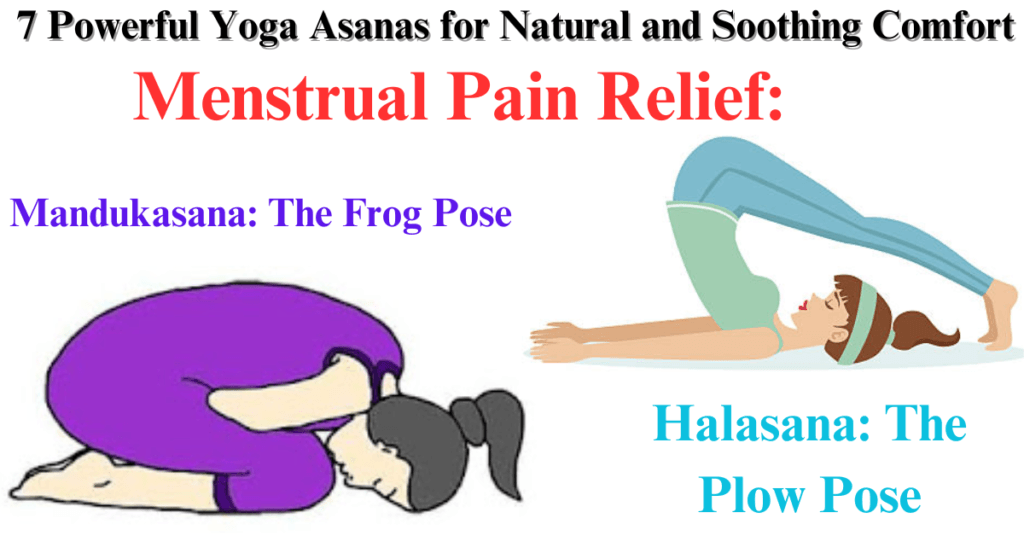
7. Halasana: The Plow Pose
Halasana, also known as the “Plow Pose,” is an advanced yet highly beneficial yoga asana that involves a deep stretch of the back, spine, and legs. Named after the shape it creates, which resembles a plow, this pose helps improve flexibility, relieve tension, and enhance overall health. Halasana is particularly effective in relieving menstrual pain, improving circulation, and calming the nervous system.
How to Perform Halasana
- Starting Position:
- Begin by lying flat on your back with your legs extended and arms by your sides, palms facing down.
- Ensure your body is relaxed, and take a few deep breaths to prepare.
- Leg Lift:
- As you inhale, lift your legs towards the ceiling, keeping them straight and together.
- Engage your core muscles to support your movement.
- Over the Head:
- Exhale and slowly lower your legs over your head, aiming to touch the floor behind you with your toes.
- Keep your legs straight, and try to keep your feet flat on the floor.
- Supporting the Back:
- Place your hands on your lower back for support, keeping your elbows firmly on the ground for balance.
- Keep your neck and head on the floor, and maintain a straight line from your shoulders to your feet.
- Hold the Pose:
- Stay in the pose for 15–30 seconds, breathing deeply and calmly.
- Keep your legs engaged and your core tight to avoid strain in the lower back.
- Release:
- To come out of the pose, slowly raise your legs back over your head and then gently lower them to the floor.
- Rest in Savasana (Corpse Pose) for a few moments to relax.
Benefits of Halasana
1. Relieves Menstrual Pain
- Halasana helps to release tension in the pelvic area and stimulates blood flow to the reproductive organs.
- It reduces menstrual cramps and discomfort by relieving pressure and improving circulation.
2. Improves Flexibility
- The pose stretches the spine, shoulders, hamstrings, and back, improving flexibility and overall mobility.
- Regular practice can alleviate stiffness in the back and improve posture.
3. Calms the Nervous System
- Halasana stimulates the parasympathetic nervous system, which helps calm the mind, reduce stress, and promote relaxation.
4. Strengthens Core and Lower Back
- The pose strengthens the abdominal muscles and the muscles in the lower back, providing better support for daily activities.
5. Stimulates Internal Organs
- The inversion nature of Halasana massages the internal organs, improving the functioning of the digestive and endocrine systems.
Precautions
- Avoid Halasana if you have:
- Neck, shoulder, or back injuries.
- High blood pressure or heart conditions.
- Glaucoma or eye problems.
- Pregnancy (due to the inversion).
- Modifications:
- If you are unable to touch your feet to the floor, use props like a block or cushion to support your feet.
- If your neck is uncomfortable, avoid placing pressure on it, and instead keep your head resting on the floor.
Halasana for Menstrual Pain Relief
For those experiencing menstrual discomfort, Halasana can be especially helpful:
- Perform the pose with caution, ensuring your abdominal muscles are engaged to avoid strain.
- Hold the pose for shorter durations in the beginning and gradually increase the time as your body becomes more accustomed to the stretch.
- Combine Halasana with deep breathing techniques to enhance relaxation and pain relief during menstruation.
Tips for Better Practice
- Warm Up Properly:
- Halasana is an intense backbend, so it’s important to warm up with gentle stretches for the back, hips, and legs before attempting this pose.
- Poses like Setu Bandhasana (Bridge Pose) or Adho Mukha Svanasana (Downward Dog) can help prepare the body.
- Engage Your Core:
- Keep your abdominal muscles engaged throughout the pose to protect your lower back.
- Focus on the smooth, controlled movement of your legs and back as you come into and out of the pose.
- Breathe Deeply:
- Slow, deep breaths help maintain balance in the pose and reduce any feelings of discomfort.
- Focus on relaxing your neck and shoulders to avoid unnecessary tension.
Halasana is a powerful yoga pose that not only enhances flexibility and strength but also provides significant relief from menstrual pain, stress, and tension. Its ability to calm the nervous system and stimulate the internal organs makes it an essential part of any yoga routine. By incorporating Halasana into your practice, you can enjoy improved circulation, reduced menstrual cramps, and a deeper sense of relaxation and well-being.
Why Yoga Works for Menstrual Pain
Yoga addresses both the physical and mental challenges of menstruation. Here’s how:
- Physical Relief: Yoga stretches and strengthens muscles, improving blood circulation in the pelvic region and reducing cramps.
- Stress Reduction: The breathing techniques and meditative aspects of yoga calm the nervous system, reducing cortisol levels and alleviating menstrual-related anxiety.
- Holistic Approach: Unlike medications, yoga works on the root causes of menstrual pain, offering a sustainable and side-effect-free solution.
